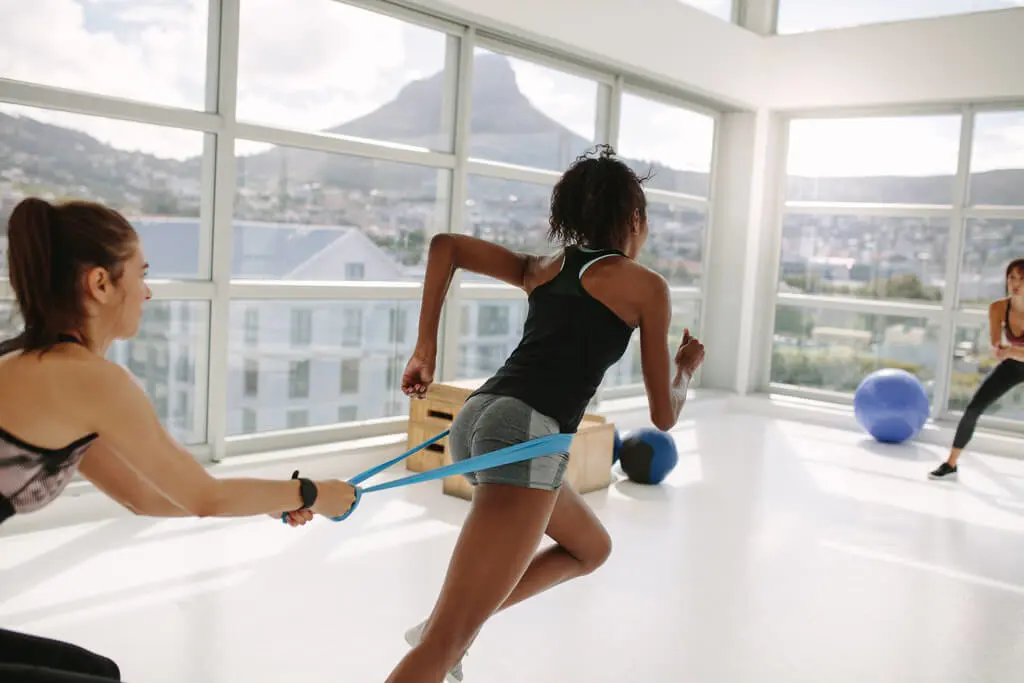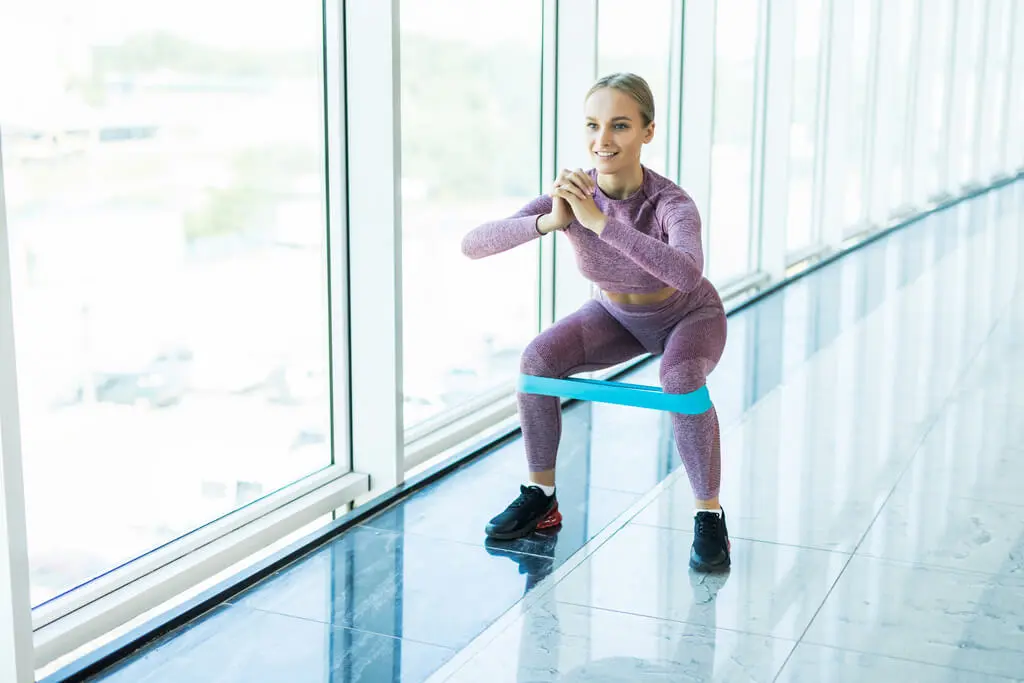How Variable Resistance Can Help You Build Strength

January 24, 2020

When you first start training with weights, you’ll often see rapid gains in your strength and fitness. However, as you get fitter and stronger, these gains tend to plateau, leaving you looking for new ways to take your strength to the next level.
Variable resistance (also referred to as ‘accommodating resistance’) training is one technique that you can use to increase your strength.
What is variable resistance training?
Variable resistance training is when you use equipment like resistance bands or even chains to vary the resistance through the range of motion of an exercise.
The aim is to create more resistance through the areas of a lift when the muscles are working in the optimum range — this is where you produce more power. It essentially allows you to lift more where you are strongest, rather than being limited by the maximal strength at the weakest part of the exercise.
This type of training adds variability, improves your overall strength and helps to break through training plateaus.

Where does the name come from?
When you perform an exercise against a resistance band, the force required to move the band changes at each point throughout the movement, due to the elastic properties of the band.
Compare this to lifting a free weight. A free weight provides constant resistance which is when the load stays consistent throughout the entire movement. When you first start to lift weights, this style of training is the most common. You’ll notice that you will be able to increase the weight gradually as you train consistently from month to month.
Once you find that you can no longer increase the weight without reducing your range of motion, introducing variable resistance training using bands to vary the resistance throughout the exercise can help you to continue to increase your strength.
Benefits of variable resistance training
Studies in the Journal of Strength and Conditioning Research show that combining resistance bands with free weights is a more effective way to improve power and force outputs than training with free weights alone.
This training style can help when you want to:
Increase power
Increase strength
Reduce or increase load at various points of an exercise
Improve neuromuscular coordination

How does variable resistance training work?
In any exercise, there is usually one section of the movement where you don’t feel as strong. Sometimes this can affect the amount of weight you can lift which ultimately reduces the maximum weight you select.
To help with this, you can use a band to increase the resistance for the strongest section of an exercise, without increasing the load in the weaker section. This allows you to get the benefits of training through your full range of motion, while still maximising your strength gains in the strongest section of the movement.
Using resistance bands alone can help to promote neuromuscular coordination as well as increasing muscular strength.
When to use variable resistance training
You can use variable resistance training in a variety of ways to help you to reach your fitness goals:
To increase power in lifts
Variable resistance training is often used to increase strength in powerlifting moves like those found in the BUILD program. If you’ve plateaued with your bench press, squat or deadlift, you might use bands or chains to assist you to strengthen the muscles through the strongest section of the exercise.
If your aim is to increase acceleration during a lift, using bands or chains can help you to do this, without loading to your 1RM (one-rep max — the maximum amount of weight you can lift for one repetition of an exercise). Using variable resistance allows you to practice producing force at a high rate of perceived exertion while reducing the risk of injury. It’s best to do this style of training with the supervision of an experienced personal trainer.

To train bodyweight exercises
You can also use resistance bands to provide variable resistance during bodyweight exercises like band assisted chin-ups. At the bottom of the chin-up, you receive more assistance from the band, and as you pull yourself up, the resistance increases as your muscles take more of your bodyweight.
Using a band can help you to maintain proper form as you build strength. When you train in this way consistently over time, you should be able to increase the number of repetitions that you can complete without the band.
To work around a physical limitation
Variable resistance can also be used to work around a physical restriction. For example, using a free weight for tricep extensions can put the elbow into an uncomfortable position, but using a resistance band in your tricep workouts may allow you to comfortably perform the exercises. If you do have an injury, make sure that you consult your health professional before loading it in any way.

For strength training at home
Resistance bands are also a convenient way to do strength training at home when you can’t make it to the gym.
How to train with variable resistance training
Here are some ways that you can include variable resistance training into your workout program:
Machines
Gym machines are a safe and simple way to add variable resistance to exercises like arm curls, leg extensions or hamstring curls. The machine helps you to easily control the load through a fixed movement path — make sure you adjust the machine to your body before beginning an exercise.

Resistance bands
For those training at home, rubber bands can provide resistance to strength exercises. You’ll find examples of these exercises in Sweat Trainer Kelsey Well’s PWR at Home program. Using a band you can add variable resistance to exercises like chest press, tricep extension, standing bicep curls or single leg press.
Resistance bands plus free weights
Resistance bands can be combined with free weights to improve strength and power in exercises like the back squat and bench press.
To improve your peak power and force in these exercises, it is recommended that free weight makes up 65-80% of the total load, with resistance from bands providing the remaining 20-35% (where the total load is the 1RM or the one-rep max).
For example, if your 1RM for a bench press is 50kg, you’ll load the bar with 20kg (remember an Olympic bar weighs 20kg) so the total weight is 40kg. You can then use bands to create variable resistance so that the total resistance at the top of the lift is approximately 50kg.
To use resistance bands safely and effectively with free weights, seek advice from an experienced personal trainer. It’s not recommended to attempt a 1RM lift unless you have a competent spotter.
Chains plus free weights
Chains are sometimes used in powerlifting training, however, there is only anecdotal evidence of the benefits. If you use chains to add resistance to a lift, ensure that a portion of the chain remains in contact with the floor at all times. This helps to prevent injury, limits sway and movement of the chain during the lift.
Use variable resistance training to break through a workout plateau
Whether you have been strength training for a while or you are just getting started, you’ll need a few workout tips as you continue to push yourself to reach a new level of fitness.
Variable resistance training is one way that you can take your training to the next level or even squeeze in a home workout if you can’t make it to the gym.

A more empowered you starts with Sweat, and our editorial team is here to bring you the latest fitness tips, trainer recommendations, wellbeing news, nutritional advice, nourishing recipes and free workouts.
* Disclaimer: This blog post is not intended to replace the advice of a medical professional. The above information should not be used to diagnose, treat, or prevent any disease or medical condition. Please consult your doctor before making any changes to your diet, sleep methods, daily activity, or fitness routine. Sweat assumes no responsibility for any personal injury or damage sustained by any recommendations, opinions, or advice given in this article.
Fitness